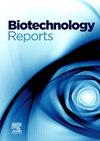Chemical-induced variations in callus regenerated Atropa acuminata plants: A study on Ethyl Methanesulfonate effects
Q1 Immunology and Microbiology
引用次数: 0
Abstract
Atropa acuminata Royle ex Lindl. a member of the solanaceae family is a critically endangered medicinal herb indigenous to the Himalayan region of Kashmir and revered for its therapeutic and economic significance. Ethyl Methanesulfonate (EMS), a chemical mutagen, is commonly used to induce mutations for plant breeding and research purposes. In this study, callus cultures derived from leaf explants of A. acuminata were cultivated on Murashige and Skoog (MS) medium supplemented with Thidiazuron (0.1 mg/l) and treated with varying concentrations of EMS (0.1%, 1.0%) over defined time intervals. The impact of EMS concentrations and exposure durations, as well as their interactions, on the characteristics of regenerated callus were rigorously examined. The proliferation of shoots exhibited a diminishing trend with escalating EMS concentrations. Additionally, EMS elicited substantial alterations in the morphological and physiological attributes of the regenerated plants. Among the fifteen traits evaluated, mutant lines designated as M10, M11, and M6 displayed the most pronounced variations in morphological and physiological parameters compared to the control. Notably, the mutant line M10 exhibited significantly elevated shoot dry weight, root fresh weight, chlorophyll, and carotenoid contents demonstrating up to 98%, 31%, 348%, and 642% enhancements respectively as compared to the control. These mutant lines hold promise for further exploitation in augmenting physiological characteristics and enhancing the yield and quality of terpene glycosides in A. acuminata.
化学诱导的刺蒺藜愈伤组织变异:甲磺酸乙酯效应的研究
火龙果(Atropa acuminata Royle ex Lindl)。茄科的一员,是一种极度濒危的草药,原产于克什米尔的喜马拉雅地区,因其治疗和经济意义而受到尊敬。甲基磺酸乙酯(EMS)是一种化学诱变剂,通常用于植物育种和研究目的的诱变。在本研究中,将刺荆叶片外植体的愈伤组织培养于Murashige和Skoog (MS)培养基上,外加0.1 mg/l的噻脲(Thidiazuron),并在规定的时间间隔内用不同浓度的EMS(0.1%、1.0%)处理。研究了EMS浓度、暴露时间及其相互作用对愈伤组织再生特性的影响。随着EMS浓度的升高,新梢的增殖呈减少趋势。此外,EMS引起了再生植株形态和生理特性的实质性改变。在15个性状中,M10、M11和M6突变系在形态和生理参数上的变化最为显著。值得注意的是,突变系M10的茎干重、根鲜重、叶绿素和类胡萝卜素含量均显著高于对照,分别提高了98%、31%、348%和642%。这些突变品系在改善荆芥生理特性、提高萜类苷产量和品质方面有进一步开发的希望。
本文章由计算机程序翻译,如有差异,请以英文原文为准。
求助全文
约1分钟内获得全文
求助全文
来源期刊

Biotechnology Reports
Immunology and Microbiology-Applied Microbiology and Biotechnology
CiteScore
15.80
自引率
0.00%
发文量
79
审稿时长
55 days
期刊介绍:
Biotechnology Reports covers all aspects of Biotechnology particularly those reports that are useful and informative and that will be of value to other researchers in related fields. Biotechnology Reports loves ground breaking science, but will also accept good science that can be of use to the biotechnology community. The journal maintains a high quality peer review where submissions are considered on the basis of scientific validity and technical quality. Acceptable paper types are research articles (short or full communications), methods, mini-reviews, and commentaries in the following areas: Healthcare and pharmaceutical biotechnology Agricultural and food biotechnology Environmental biotechnology Molecular biology, cell and tissue engineering and synthetic biology Industrial biotechnology, biofuels and bioenergy Nanobiotechnology Bioinformatics & systems biology New processes and products in biotechnology, bioprocess engineering.
 求助内容:
求助内容: 应助结果提醒方式:
应助结果提醒方式:


